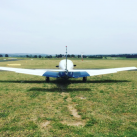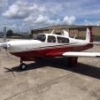Search the Community
Showing results for tags 'IMC'.
-
Spent a lot of time in the clouds over the holiday, flying to KC from Atlanta on Wednesday ahead of that big system, getting stuck in KC for two days because of icing potential, and then flying through the system on the way home. It was good practice and overall renewed my confidence in clouds since we seldom get much of that in the summer. But I had an interesting and brief encounter with spatial disorientation on the outbound leg. I'd been tooling along in solid IMC at 6000' (to avoid winds) and all of a sudden I got to a little break. There was a sliver of clear sky and ground that I could see ahead of me, with just one small puffy between me and it. And for some reason, my brain just started to go wacko, and that little sliver of clear space started moving sideways and up and down like it was coming after me. It was only a few seconds, and I just quickly transitioned my view back to the panel and that wondrous big synthetic vision screen, so all was well. But that was the first time I ever really remember that happening to me, and it was educational to learn how quickly it can occur. That IPC I had in October keeps paying dividends!
-
So, to continue with supplementing my education in IFR, I have been reading Pilot error: Anatomies of aircraft accidents by the Editors of Flying Magazine, after a suggestion posted here and I have found it riveting. Then yesterday, during the course of conversation on an unrelated topic, one of the people that works for me mentioned something about knowing a pilot that was killed in a crash. He didn't have much data on the accident, but I was able to drill down through the NTSB database and located the incident. What I found was somewhat shocking, but eerily coincident with a question that I was thinking about posting here for comment. Coincidentally, there is a recent thread about logging IFR proficiency that I found interesting as well. For background, here is the operative excerpt from the report: An operations staff member at JAS stated that it seemed to be common knowledge among airport personnel (staff, airplane owners, and other pilots) that although the pilot was not instrument rated, he frequently filed instrument flight plans, and operated in instrument meteorological conditions (IMC). The operations staff member had heard other pilots complain about the pilot's flying habits in the vicinity of JAS, and in particular when IMC existed at JAS. The investigation was unable to obtain additional details regarding those observations. It occurred to me that any pilot might simply file an IFR FP, TO into IMC, fly wherever, execute an approach, land and go on his merry way. How would the FAA know that he was not instrument rated? Then I thought, wait, surely they check the pilot name on the FP against the airman DB, no? Apparently not. As an aside, and of course we don't know exactly what happened, but it appears that IMC took out this man, his wife and his 9 YO son.
-
I have been doing a lot of IFR studying on my own and have a question that I hope someone can answer. When you TO into an IFR flight plan, are you in contact with ATC and do they have you on radar via your transponder? In other words, is it just like flight following but under IMC? If you miss a fix or are unable to figure out where you are via VOR, do they just tell you? Do they vector you back where you need to be if you get lost?
-
One of the best tools I've ever found for planning cross country flights is one that it seems few people know about. Go to weather.aero, where you'll find an experimental adds site from faa / ncar (national center for atmospheric research). The site is good, but check out the flight path tool under desktop apps. It is a java app that works on mac or pc. The brilliance is that it gives you access to the 3 dimensional current/forecast model of the atmosphere. You put in a route of flight, and you can see VERTICAL cross sections as well as an area view for the weather aspect you choose. If you turn on relative humidity, for instance, you can see where the cloud layers and tops are forecast. It is brilliant. Anyone else been using this? it is the only way I've found to plan long trips particularly where there is imc with chances of icing I'd like to avoid... Greg






